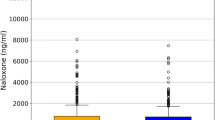Abstract
Introduction
Dextromethorphan hydrobromide is widely available as an over-the-counter cough suppressant. A semi-synthetic opioid displaying N-methyl-d-aspartate receptor antagonism, it is commonly abused for recreational purposes. Spuriously elevated serum chloride concentrations are a well-described phenomenon in the setting of dextromethorphan hydrobromide toxicity, but evidence to suggest the development of tolerance is limited to case reports.
Case
A 32-year-old male known to chronically ingest dextromethorphan hydrobromide for recreational purposes presented to regional hospitals on 179 occasions over 110 months and was treated for dextromethorphan toxicity on 163/174 (93.7%) of these visits. He reported a subjective need to increase his dosing over time to achieve the same degree of intoxication. Measured serum chloride over this period (n = 217) ranged from 98 to 138 mEq/L (median 115 mEq/L, IQR 110–123 mEq/L). Measured concentrations over the 110-month period progressively rose, with a fitted plot of 111.15 + 0.00232x describing the rise in measured chloride. Though not formally assessed, anion gaps tended to become progressively more negative over the observed period.
Discussion
We report a patient with persistent dextromethorphan hydrobromide abuse at escalating doses whose mean serum chloride concentration increased, on average, by 0.00232 mEq/L every day over a 110-month period. This case demonstrates progressive spurious hyperchloremia secondary to bromide interference in hospital-based chloride assays, supporting the patient’s reported need to dose escalate to the same desired effect. Although this artefactual laboratory finding is a well-documented result of bromide ingestion, it may be useful in identifying patterns of dextromethorphan hydrobromide use that suggest tolerance.




Similar content being viewed by others
References
Boyer EW. Dextromethorphan abuse. Pediatr Emerg Care. 2004;20(12):858–63.
Romanelli F, Smith KM. Dextromethorphan abuse: clinical effects and management. J Am Pharm Assoc. 2009;49(2):e20–7.
Spangler DC, Loyd CM, Skor EE. Dextromethorphan: a case study on addressing abuse of a safe and effective drug. Subst Abus Treat Prev Policy. 2016;11(1):1–7.
Storck M, Black L, Liddell M. Inhalant abuse and dextromethorphan. Child Adolesc Psychiatr Clin N Am. 2016;25(3):497–508.
Wilson MD, Ferguson RW, Mazer ME, Litovitz TL. Monitoring trends in dextromethorphan abuse using the National Poison Data System: 2000-2010. Clin Toxicol. 2011;49(5):409–15.
Miller SC. Dextromethorphan psychosis, dependence and physical withdrawal. Addict Biol. 2005;10(December):325–7.
Bergman U, Myrhed M. Tolerance and withdrawal with zolpidem. Lancet. 1993;342(August 7):373–4.
Jones R, Benowitz N, Herning R. Clinical relevance of cannabis tolerance and dependence. J Clin Pharmacol. 1981;21(8–9 Suppl):143S–52S.
Emancipator K, Kroll MH. Bromide interference: is less really better? Clin Chem. 1990;36(8):1470–3.
Finn N, Wolf J, Louie J, Su B. High concentrations of dextromethorphan result in false-positive in opiate immunoassay test. Clin Chim Acta. 2015;448(June):247.
Schier J, Diaz JE. Avoid unfavorable consequences: dextromethorphan can bring about a false-positive phencyclidine urine drug screen. J Emerg Med. 2000;18(3):379–83.
Hung Y-M. Bromide intoxication by the combination of bromide-containing over-the-counter drug and dextromethorphan hydrobromide. Hum Exp Toxicol. 2003;22:459–61.
Stanciu CN, Penders TM, Rouse EM. Recreational use of dextromethorphan, “Robotripping”—a brief review. Am J Addict. 2016;25(August):374–7.
Nguyen L, Robson MJ, Healy JR, Scandinaro AL, Matsumoto RR. Involvement of sigma-1 receptors in the antidepressant-like effects of dextromethorphan. PLoS One. 2014;9(2):e89985.
Ng Y, Lin W, Chen T, Lin B, Tsai S, Huang T. Spurious hyperchloremia and decreased anion gap in a patient with dextromethorphan hydrobromide. Am J Nephrol. 1992;12(4):268–70.
Hsieh PF, Tsan YT, Hung DZ, Hsu CL, Lee YC, Chang MH. Bromism caused by mix-formulated analgesic injectables. Hum Exp Toxicol. 2007;26(12):971–3.
Wenk RE, Lustagarten JA, Pappas NJ, Levy RI, Jackson R. Serum chloride analysis, bromide detection, and the diagnosis of bromism. Am J Clin Pathol. 1976;65:49–57.
Rehak N, Andersen T. Evaluation of Gilford chemistry control interference with the chloride method in the Beckman Synchron CX3 system analyzer: cumulative effect of bromide on chloride results. I. Clin Chem. 1989;35(7):1538.
Rothenberg DM, Berns AS, Barkin R, Glantz RH. Bromide intoxication secondary to pyridostigmine bromide therapy. JAMA J Am Med Assoc. 1990;263(8):1121–2.
Ito T, Ishikawa E, Matsuda Y, Tanoue A, Fujimoto M, Matsuo H, et al. Elevated serum levels of bromine do not always indicate pseudohyperchloremia. Clin Exp Nephrol. 2010;14(5):431–5.
Gummin DD, Mowry JB, Spyker DA, Brooks DE, Fraser MO, Banner W. 2016 Annual Report of the American Association of Poison Control Centers’ National Poison Data System (NPDS): 34th Annual Report. Clin Toxicol. 2017;55(10):1072–252.
Fleming PM. Dependence on dextromethorphan hydrobromide. Br Med J (Clin Res Ed). 1986;293(September):597–8.
Bowers G, Onoroski M. Hyperchloremia and the incidence of bromism in 1990. Clin Chem. 1990;36(8):1399–403.
Funding
None.
Author information
Authors and Affiliations
Contributions
All authors participated in editing and rewriting the manuscript. SS and TO prepared the initial draft. TO prepared the statistical analysis and figure(s) and consented the patient. TO conducted all data abstraction. SB initially approached patient for consent to publish this case report and provided editorial input for the final manuscript. Jenna LeRoy provided editorial input for the final manuscript.
Corresponding author
Ethics declarations
Consent for publication of this case was obtained and provided to the journal in accordance with JMT policy.
Conflict of Interest
None.
Additional information
Publisher’s Note
Springer Nature remains neutral with regard to jurisdictional claims in published maps and institutional affiliations.
Rights and permissions
About this article
Cite this article
Olives, T.D., Boley, S.P., LeRoy, J.M. et al. Ten Years of Robotripping: Evidence of Tolerance to Dextromethorphan Hydrobromide in a Long-Term User. J. Med. Toxicol. 15, 192–197 (2019). https://doi.org/10.1007/s13181-019-00706-1
Received:
Revised:
Accepted:
Published:
Issue Date:
DOI: https://doi.org/10.1007/s13181-019-00706-1




